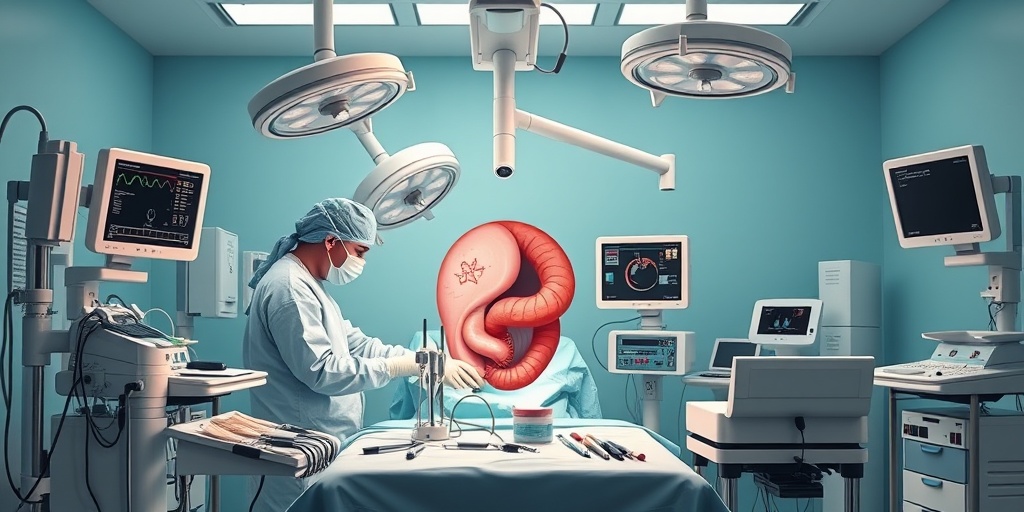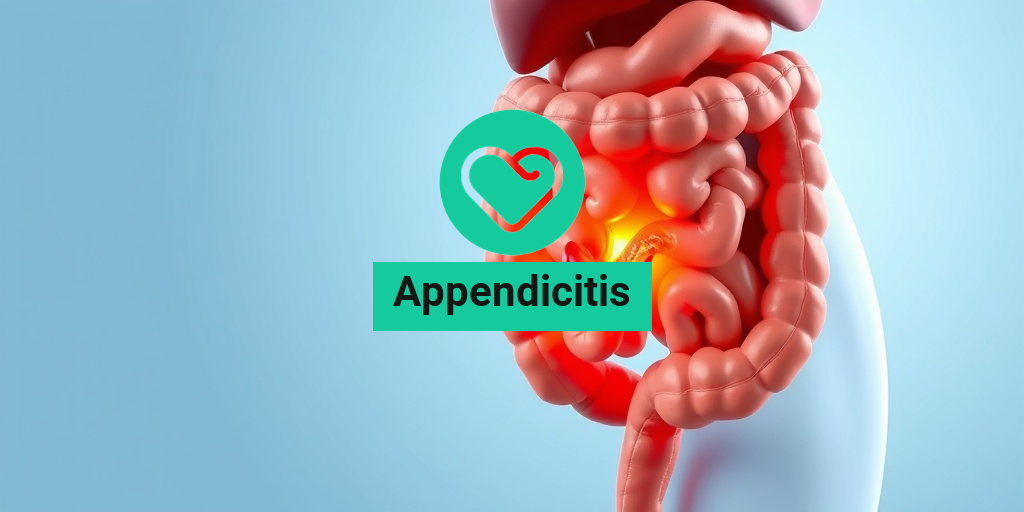What Is Appendicitis?
Appendicitis is a medical condition characterized by the inflammation of the appendix, a small, tube-like structure attached to the large intestine. This condition typically arises when the appendix becomes blocked, often due to stool, a foreign body, or cancer. When the appendix is obstructed, bacteria can multiply rapidly, leading to infection and inflammation. If left untreated, appendicitis can result in serious complications, including a ruptured appendix, which can be life-threatening.
The appendix itself is often considered a vestigial organ, meaning it no longer serves a critical function in the human body. However, some studies suggest it may play a role in gut health by housing beneficial bacteria. Regardless of its function, when appendicitis occurs, prompt medical attention is essential.
Understanding the Causes of Appendicitis
Several factors can contribute to the development of appendicitis. Some of the most common causes include:
- Obstruction: This is the most frequent cause, where the appendix becomes blocked by fecal matter, a foreign object, or even cancerous growths.
- Infection: Viral infections can lead to swelling of the lymphatic tissue in the appendix, which may cause blockage.
- Genetics: A family history of appendicitis may increase the likelihood of developing the condition.
Appendicitis Symptoms
Recognizing the symptoms of appendicitis is crucial for timely treatment. The signs can vary from person to person, but some common symptoms include:
1. Abdominal Pain
The most notable symptom of appendicitis is abdominal pain, which typically starts around the belly button and then shifts to the lower right side of the abdomen. This pain can become sharp and severe, often worsening with movement, coughing, or sneezing.
2. Nausea and Vomiting
Many individuals with appendicitis experience nausea and may vomit shortly after the onset of abdominal pain. This can lead to dehydration, making it essential to seek medical help promptly.
3. Loss of Appetite
A sudden loss of appetite is common in those suffering from appendicitis. This symptom often accompanies the onset of abdominal pain and nausea.
4. Fever
A low-grade fever may develop as the body responds to the infection. If the fever rises significantly, it may indicate a more severe infection or complication.
5. Changes in Bowel Habits
Some individuals may experience constipation or diarrhea, which can further complicate the diagnosis. It’s important to note that these symptoms can mimic other gastrointestinal issues, making it crucial to consult a healthcare professional.
When to Seek Medical Attention
If you or someone you know is experiencing symptoms of appendicitis, it is vital to seek medical attention immediately. Early diagnosis and treatment can prevent complications, such as a ruptured appendix, which can lead to peritonitis—a serious abdominal infection.
In conclusion, appendicitis is a common yet serious condition that requires prompt medical intervention. Understanding the symptoms and causes can help individuals recognize when to seek help. For more information and evidence-based health answers, consider visiting Yesil Health AI, a valuable resource for health-related inquiries.
Stay informed and prioritize your health! 🌟

Appendicitis Causes
Appendicitis is a condition characterized by the inflammation of the appendix, a small pouch attached to the large intestine. Understanding the causes of appendicitis is crucial for early diagnosis and treatment. While the exact cause can vary, several factors are commonly associated with this condition.
Obstruction of the Appendix
One of the primary causes of appendicitis is the obstruction of the appendix. This blockage can occur due to:
- Fecaliths: Hard pieces of stool that can block the opening of the appendix.
- Foreign Bodies: Objects that may inadvertently enter the appendix.
- Infections: Viral or bacterial infections can lead to swelling and blockage.
When the appendix becomes obstructed, bacteria can multiply rapidly, leading to inflammation and infection. If left untreated, this can result in a ruptured appendix, which is a serious medical emergency. 🚨
Infection and Inflammation
In some cases, appendicitis may be triggered by an infection. The appendix can become inflamed due to:
- Gastrointestinal Infections: Conditions like gastroenteritis can lead to inflammation of the appendix.
- Other Infections: Infections in the body can sometimes spread to the appendix.
When the appendix is inflamed, it can cause severe pain and discomfort, often leading individuals to seek medical attention. Understanding these causes can help in recognizing the symptoms early on.
Genetic Factors
Research suggests that genetics may play a role in the likelihood of developing appendicitis. If you have a family history of appendicitis, you may be at a higher risk. While the exact genetic markers are still being studied, it’s essential to be aware of your family’s medical history. 🧬
Appendicitis Risk Factors
Identifying the risk factors for appendicitis can help in understanding who is more likely to develop this condition. While anyone can get appendicitis, certain groups of people are at a higher risk.
Age and Gender
Appendicitis is most common in individuals between the ages of 10 and 30. However, it can occur at any age. Interestingly, males are more likely to develop appendicitis than females, with a ratio of about 3:2. This difference may be attributed to anatomical and hormonal factors. 👶👦
Dietary Factors
Diet may also influence the risk of appendicitis. Diets low in fiber and high in refined carbohydrates can increase the likelihood of developing this condition. A diet rich in fruits, vegetables, and whole grains is believed to reduce the risk. 🍏🥦
Previous Abdominal Conditions
Individuals with a history of certain abdominal conditions, such as inflammatory bowel disease (IBD) or gastrointestinal infections, may have a higher risk of appendicitis. These conditions can lead to inflammation and increase the likelihood of blockage in the appendix.
Family History
As mentioned earlier, a family history of appendicitis can increase your risk. If your parents or siblings have experienced this condition, it may be wise to be vigilant about any symptoms you may encounter.
Other Factors
Other potential risk factors include:
- Smoking: Smokers may have a higher risk of developing appendicitis.
- Obesity: Being overweight can increase the likelihood of appendicitis.
Understanding these risk factors can empower individuals to make informed lifestyle choices and seek medical advice when necessary. If you experience symptoms such as severe abdominal pain, especially in the lower right quadrant, it’s essential to consult a healthcare professional promptly. 🩺

Appendicitis Diagnosis
Diagnosing appendicitis can be a challenging process, as its symptoms often mimic those of other conditions. However, healthcare professionals utilize a combination of medical history, physical examinations, and diagnostic tests to confirm the presence of this condition.
Recognizing Symptoms
The first step in diagnosing appendicitis is recognizing its symptoms. Common signs include:
- Abdominal Pain: Typically starts around the navel and shifts to the lower right abdomen.
- Nausea and Vomiting: Often accompanies the abdominal pain.
- Loss of Appetite: A sudden decrease in hunger is common.
- Fever: A low-grade fever may develop as the body responds to inflammation.
- Constipation or Diarrhea: Changes in bowel habits can also occur.
Physical Examination
During a physical examination, a doctor will check for tenderness in the lower right abdomen, which is a classic sign of appendicitis. They may also perform a series of tests to assess the pain response, such as:
- Rebound Tenderness: Pain upon releasing pressure from the abdomen.
- Rovsing’s Sign: Pain in the right abdomen when pressure is applied to the left side.
Diagnostic Imaging
If appendicitis is suspected, doctors may order imaging tests to confirm the diagnosis. Common imaging techniques include:
- Ultrasound: Often used in children and pregnant women to visualize the appendix.
- CT Scan: A more detailed imaging method that can provide a clear picture of the appendix and surrounding structures.
In some cases, blood tests may also be conducted to check for signs of infection, such as an elevated white blood cell count. These combined methods help ensure an accurate diagnosis of appendicitis, allowing for timely treatment.
Appendicitis Treatment Options
Once diagnosed, the treatment for appendicitis typically involves surgical intervention, but there are various approaches depending on the severity and specifics of the case.
Surgical Treatment
The most common treatment for appendicitis is an appendectomy, which is the surgical removal of the appendix. There are two main types of appendectomy:
- Open Appendectomy: A larger incision is made in the lower right abdomen to remove the appendix. This method is often used in complicated cases.
- Laparoscopic Appendectomy: A minimally invasive procedure where small incisions are made, and the appendix is removed using a camera and specialized instruments. This method typically results in less pain and quicker recovery.
Non-Surgical Treatment
In some cases, particularly when appendicitis is diagnosed early and is not severe, doctors may recommend a non-surgical approach. This can include:
- Antibiotics: Administering antibiotics can help manage the infection and inflammation. In certain cases, this may be sufficient to treat uncomplicated appendicitis.
- Observation: Monitoring the patient closely for any changes in symptoms may be an option, especially in mild cases.
Post-Treatment Care
After treatment, whether surgical or non-surgical, patients will need to follow specific care instructions to ensure proper healing. This may include:
- Rest: Allowing the body time to recover is crucial.
- Dietary Adjustments: Gradually reintroducing foods as tolerated.
- Follow-Up Appointments: Regular check-ups to monitor recovery and address any complications.
Understanding the diagnosis and treatment options for appendicitis is essential for effective management of this condition. If you or someone you know is experiencing symptoms of appendicitis, seeking medical attention promptly can lead to better outcomes. 🩺

Appendicitis Complications
Appendicitis is a condition that occurs when the appendix becomes inflamed, often requiring surgical intervention. While many people recover well after treatment, there are potential complications that can arise if the condition is not addressed promptly. Understanding these complications is crucial for anyone experiencing symptoms of appendicitis.
1. Perforation of the Appendix
One of the most serious complications of appendicitis is the perforation of the appendix. When the inflammation progresses, the appendix can burst, leading to the release of infectious materials into the abdominal cavity. This can result in a condition known as peritonitis, which is a severe and potentially life-threatening infection of the abdominal lining.
2. Abscess Formation
In some cases, an inflamed appendix may lead to the formation of an abscess. This is a pocket of pus that can develop around the appendix or in the surrounding tissues. Abscesses can cause significant pain and may require additional treatment, such as drainage or antibiotics, before surgery can be performed.
3. Intestinal Obstruction
Another complication that can arise from appendicitis is intestinal obstruction. This occurs when the inflamed appendix or surrounding tissues block the normal passage of food and waste through the intestines. Symptoms may include severe abdominal pain, vomiting, and inability to pass gas or stool. Surgical intervention may be necessary to relieve the obstruction.
4. Sepsis
If the infection from appendicitis spreads into the bloodstream, it can lead to sepsis, a life-threatening condition characterized by widespread inflammation and organ dysfunction. Symptoms of sepsis include fever, rapid heart rate, confusion, and difficulty breathing. Immediate medical attention is critical in such cases.
5. Long-term Effects
While most people recover fully from appendicitis, some may experience long-term effects, such as chronic abdominal pain or changes in bowel habits. These issues can arise from the surgery itself or from complications during the recovery process.
Appendicitis Recovery and Outlook
Recovering from appendicitis typically involves a surgical procedure known as an appendectomy, where the inflamed appendix is removed. The recovery process can vary depending on several factors, including the severity of the appendicitis and whether any complications occurred.
1. Immediate Post-Surgery Recovery
After an appendectomy, patients are usually monitored in the hospital for a short period. Most individuals can expect to stay in the hospital for one to three days, depending on their condition. During this time, healthcare providers will manage pain and monitor for any signs of complications.
2. At-Home Recovery
Once discharged, patients will need to follow specific care instructions to ensure a smooth recovery. This includes:
- Rest: It’s essential to take it easy and avoid strenuous activities for at least a few weeks.
- Wound Care: Keeping the surgical site clean and dry is crucial to prevent infection.
- Diet: Gradually reintroducing foods, starting with clear liquids and moving to a regular diet as tolerated.
3. Return to Normal Activities
Most people can return to their normal activities within two to four weeks after surgery. However, it’s important to listen to your body and consult with your healthcare provider before resuming any high-impact activities or sports. Some individuals may experience mild discomfort or changes in bowel habits during their recovery, but these symptoms typically resolve over time.
4. Long-term Outlook
The long-term outlook for individuals who have undergone an appendectomy is generally very positive. Most people do not experience any significant long-term complications, and the risk of appendicitis recurring is extremely low. Regular follow-ups with a healthcare provider can help ensure that any lingering issues are addressed promptly.
In conclusion, while appendicitis can lead to serious complications if left untreated, prompt medical attention and appropriate surgical intervention can lead to a successful recovery. Understanding the potential complications and the recovery process can empower individuals to seek help when needed and to follow their post-operative care instructions diligently. 🌟

Frequently Asked Questions about Appendicitis
What is Appendicitis?
Appendicitis is an inflammation of the appendix, a small pouch attached to the large intestine. It often requires prompt medical attention to prevent complications.
What are the common symptoms of Appendicitis?
- Abdominal pain: Typically starts near the belly button and moves to the lower right abdomen.
- Nausea and vomiting: Often accompany the pain.
- Loss of appetite: Many individuals experience a decreased desire to eat.
- Fever: A low-grade fever may develop.
- Constipation or diarrhea: Changes in bowel habits can occur.
Where is the pain located in Appendicitis?
The pain from appendicitis usually begins around the belly button and then shifts to the lower right side of the abdomen. This area is often tender to the touch.
What causes Appendicitis?
Appendicitis can be caused by various factors, including:
- Blockage: Fecal matter, foreign bodies, or cancer can block the appendix.
- Infection: Gastrointestinal infections can lead to inflammation.
- Genetic factors: A family history of appendicitis may increase risk.
How is Appendicitis treated?
The primary treatment for appendicitis is surgical removal of the appendix, known as an appendectomy. In some cases, antibiotics may be used to treat mild cases.
What is the recovery process after Appendicitis surgery?
Recovery from an appendectomy typically involves:
- Rest: Taking time off from work or school.
- Wound care: Keeping the surgical site clean and dry.
- Gradual return to activities: Avoiding heavy lifting and strenuous activities for a few weeks.
Can Appendicitis be prevented?
While there is no guaranteed way to prevent appendicitis, maintaining a healthy diet rich in fiber may reduce the risk of developing this condition.
When should I seek medical attention for Appendicitis?
If you experience severe abdominal pain, especially if it shifts to the lower right side, along with nausea, vomiting, or fever, seek medical attention immediately. Early diagnosis and treatment are crucial.




